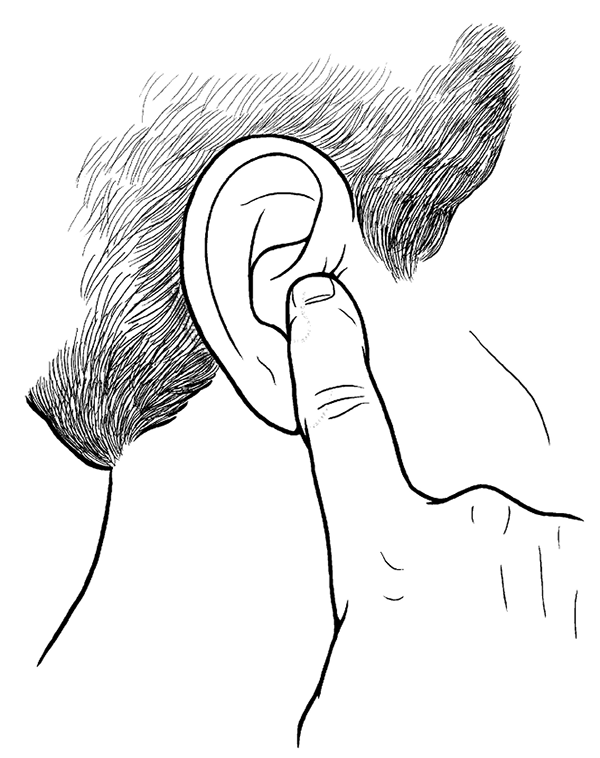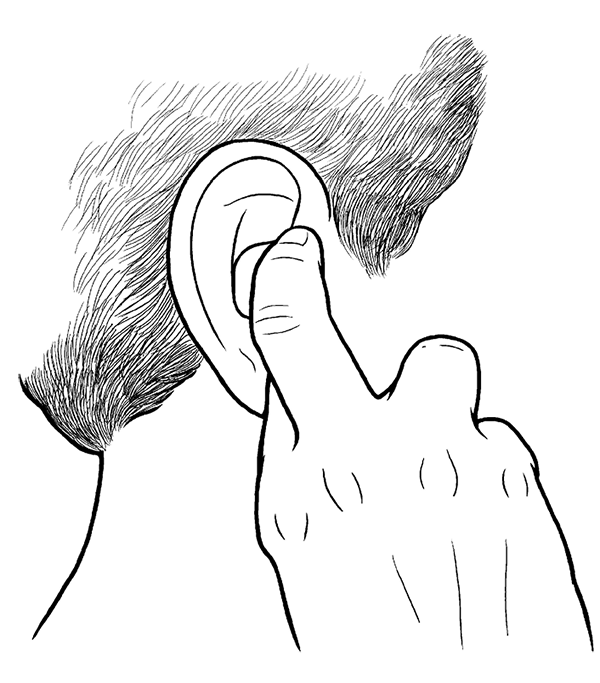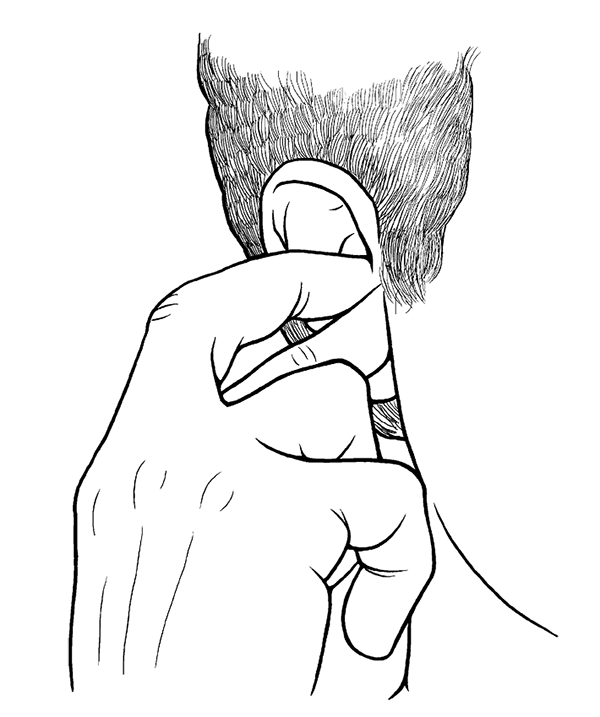Chinese Healing Exercises (24 page)
Read Chinese Healing Exercises Online
Authors: Steven Cardoza
Tags: #Taiji, #Qi Gong, #Daoist yoga, #Chinese Healing, #Health, #medicine, #remedy, #energy
Now that you've found each point, you can treat them in this way. Follow the order
given above, as that will direct any pathology outward, and create a slight lift to assist in cos
metic purposes at the same time. If you felt tenderness or pain with slight pressure while locating them, start with just direct pressure, enough to feel that tenderness. Hold it for about ten seconds, and then remove the pressure. This will help release any muscle tension held there and begin to disperse stagnant or stuck qi. Treat each point in this way. You can repeat this three times on each point. After a week or two, the tenderness should diminish. At that time, or if the points were not tender to begin with, apply some pressure to each point and make very small circles with your fingertips. The circling motion will disperse stagnant qi more effectively, and create more energetic motion so that more healthy qi will be drawn to those points as needed. This is useful and beneficial even if your eyes are completely healthy.
4. Four Directions Eye Exercise
This is an easy set to describe and to perform, and can be done anywhere and anytime. The four directions are:
1. Up and down.
2. Side to side.
3. Diagonally up in one direction to diagonally down in the other direction, both sides.
4. Circles, both clockwise and counterclockwise.
Here's one convenient way to begin this practice. Sit in a chair, facing a wall or an object directly in front of your line of sight as you look straight forward. If you're facing a wall, find a spot, place, or small picture directly in front of you. The object or spot will serve as a point of reference and help keep your eye motion as uniform as possible. Without moving your head, look upward as far as your eyes allow, and find something you can clearly focus on and spot each time you look up. Then look back at the spot directly in front of you. Then, again without moving your head, look downward as far as your eyes allow, and find something you can clearly focus on and spot each time you look down. Then look back at the spot directly in front of you. Tracing as straight a line as possible with your eyes, alternately look up and down, finding the spots you've picked out, including the one directly in front of you. Do this ten to twelve times, deliberately and at a moderate to slow pace.
Next, without moving your head, look to the left as far as your eyes allow, and find something you can clearly focus on and spot each time you look left. Then look back at the spot directly in front of you. Again without moving your head, look to the right as far as your eyes allow, and find something you can clearly focus on and spot each time you look right. Then look back at the spot directly in front of you. Tracing as straight a line as possible with your eyes, alternately look left and right, finding the spots you've picked out, including the one directly in front of you. Do this ten to twelve times, deliberately and at a moderate to slow pace.
Next, without moving your head, look diagonally up to the left as far as your eyes allow, and find something you can clearly focus on and spot each time you look left. Then look back at the spot directly in front of you. Then, again without moving your head, look diagonally down to the right as far as your eyes allow, and find something you can clearly focus on and spot each time you look right. Then look back at the spot directly in front of you. Tracing as straight a line as possible with your eyes, alternately look up to the left and down to the right, finding the spots you've picked out, including the one directly in front of you. Do this ten to twelve times, deliberately and at a moderate to slow pace. Then reverse the directions, looking up to the right and down to the left for the same number of times.
Finally, make circles with your eyes. You can start with either clockwise or counterclockwise circles. Here, you won't be looking at the spot directly in front of you, but you can locate the other eight spots you selected in the previous exercises as you circle your eyes, again to ensure the most uniform eye movement possible. After circling your eyes ten to twelve times in one direction, reverse the direction of the circles for the same number of times.
This exercises the muscles that move your eyeballs. Those muscles attach all around the sides and rear of the eye, and allow for all the movements your eyes can make. The Chinese consider eyes that are capable of free, quick movement to be a sign of intelligence. As with any muscle, the ability to move freely and without pain requires the nourishment of blood and the qi and other nutrients it contains. Since the backs of the eyes connect almost directly with the brain, more blood drawn to that area benefits the brain as well. If you feel tenderness or discomfort as you move your eyes in any direction, it indicates that the muscles responsible for that movement are weak or tight, and they will get achy in the same way any other muscle will when weak or tight.
Place some attention on your breathing as you do these eye exercises. While you don't have to breathe in any particular way, you may find that you hold your breath for some or all of these exercises. The Liver is responsible for the smooth flow of qi throughout the body. An unconsciously held breath indicates a disruption in qi flow, and smooth, deep breaths promote an unobstructed course. Do your best to keep your breathing even and regular throughout this exercise in particular.
4A. Eye Focus Exercise
This is not, to the best of my knowledge, specifically a Chinese exercise, but it is a type of continuation of the previous exercise. Our eyes focus because there are very tiny muscles that contract and relax to pull on the lenses within each eye. That pulling and relaxing makes the lens more convex or less convex, when viewed from the front, allowing for near and far focus. Now, the lens itself may harden some over time, becoming less flexible, but to whatever extent it remains supple, the strength of the muscles that shape the lens determines our clarity of focus. These days, most people spend too much time indoors, working with computers and other devices up close, so there's less opportunity to exercise those small muscles beyond that narrow range. This focus exercise helps to remedy that, and may improve vision with practice over time.
Before sitting in a chair as above, place a magazine or newspaper, something with relatively large print of differing sizes, open to any page with such print propped upright at one end of the room. Place your chair at a distance where you can read the print when covering either eye. Hold a paperback book, a newspaper, magazine, matchbook cover, anything with small print, in your left hand, and sit in the chair. Cover your right eye with your right hand, and with your left eye, look at the printed page at the far end of the room. Clearly focus on the smallest size of print that you can read. Then lift your left hand to just below the height of your left eye, and hold the book or printed material as close to that eye as you can and still be able to clearly read print on that item. Shift your focus back and forth between the near and far print, making sure you can clearly read the letters you are looking at. Shift your focus back and forth ten to twelve times. Then place the book in your right hand, cover your left eye with your left hand, and repeat the exercise with your right eye. You may need to focus on larger print, or hold the book farther away, when using your other eye. That's okay; just pick a the smallest print size you can read, and the closest distance you can focus on.
After a few weeks of daily practice, you may find you can read more clearly, possibly even not needing glasses to read things you would have in the past. All the other benefits of the previous exercise apply here on a finer, more subtle scale, as we are working with even smaller physiological structures.
5. Eye Cupping
This is another exercise that can be done anywhere and anytime, to soothe tired, overworked eyes. In the context of this set of eye exercises, doing it at the end of the practice will comfort eyes that have just been worked in some unfamiliar ways.
Sitting or standing, rub your hands together until they are comfortably warm. The friction from rubbing your hands together generates that warmth, which then dilates the
blood vessels and brings more blood to your hands. Supportively, the increased blood in your hands makes them warmer still. People adept at the practice of qigong can make their hands warm just by using their mind to direct the qi there. In Chinese medicine, there is a saying: “The Qi is the commander of the Blood, but the Blood is the mother of the Qi.” This means that qi, energy, is required to move the blood wherever it goes in the body, and that wherever there is more blood, there can be more qi, since qi requires healthy blood as a medium from which to grow and flourish. Even if you can't feel qi, more is present in your hands after rubbing them together to bring blood there. Now, place the palms of your hands over your eyes, and let the warmth penetrate your eyes. That warmth is an aspect of qi, so more qi will penetrate your eyes at the same time, helping them to become more comfortable and healthy.
If you have trouble understanding this from the standpoint of Chinese energetics, consider it from a basic scientific standpoint. If you were to observe your hands using night vision goggles, which detect infrared radiation, you would see that your hands appear brighter, as they are giving off more infrared radiation in the form of heat. All biological energy is qi, and the infrared radiation generated by your body is just one part of that biological energy, one part of your qi.
Ear Exercises
6. Beating the Heavenly Drum
Moving down from the eyes, the next sense organs addressed are the ears. These exercises will help keep your ears healthy and your hearing strong well into old age. The ears are the sense organs associated with the Kidneys, so any problems you have with your ears may reflect a problem with Kidney function, any benefit to your ears will benefit your Kidneys, and exercises found elsewhere in this book that benefit your Kidneys will benefit your ears as well.
Beating the Heavenly Drum makes use of a gentle paidagong, a tapping and patting technique used in various exercises throughout this book that breaks up stagnant qi and stimulates local qi flow. It is commonly practiced in two different but related ways. The first way is the simplest, and getting the sense of the Heavenly Drum here will make it easier to get the Heavenly Drum in the second approach. Sitting comfortably, place the tips of your index fingers on the small triangular flap of cartilage and skin directly in front of your ear canal. Push that flap firmly so that it fully closes the opening to your ear, and hold it in place there
(
Fig 8.4A
).
Use your middle fingers to tap on the fingernail of your index fingers, so that you hear a drumlike beat within your ear
(
Fig 8.4B
).
Keep the beats as even as possible, and tap thirty-six times.
(
Fig 8.4C
).


Figures 8.4A and 8.4B (Beating the Heavenly Drum)
 Figure 8.4C (Beating the Heavenly Drum)
Figure 8.4C (Beating the Heavenly Drum)